
(Photo from Biostatech website)
Following on from successful meetings back in January 2011 and 2013, on the 20-21 January 2017 Biostatnet members gathered again in Santiago to celebrate the network’s successes and discuss future challenges. These are our highlights:
Invited speakers
The plenary talk, “Why I Do Clinical Trials: Design and Statistical Analysis Plans for the INVESTED Trial”, introduced by Guadalupe Gómez Melis, was given by Prof. KyungMann Kim, from the Biostatistics and Medical Informatics department at the University of Wisconsin. Prof. Kim discussed challenges faced when conducting clinical trials to ensure follow-up of patients, and the technological and statistical conflicts in the endeavour to make large-scale clinical trials cost-efficient.
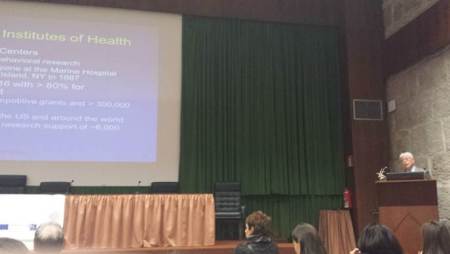
Prof. KyungMann Kim’s presenting his work
The invited talk by Miguel Ángel Martínez Beneito from FISABIO showcased solutions to issues with excess zeros modelling in disease mapping in a very enjoyable talk that generated a fascinating discussion.
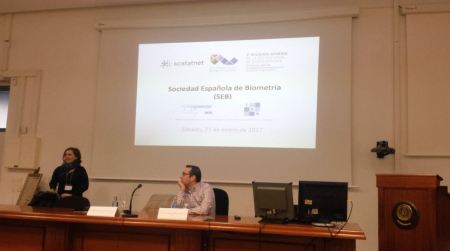
Inmaculada Arostegui introducing Miguel Ángel Beneito’s talk
Roundtables
We really enjoyed the two great roundtables that were held at the meeting.
Young Researchers Roundtable
Firstly, we were delighted to be given the opportunity to organise a roundtable of young researchers at the event, and although we did not have much time, we managed to squeeze in four main topics of discussion including; Biostatnet research visits, reproducibility in research, professional visibility and diversity with a focus on women in Biostatistics (very fittingly just before the celebrations of the 1st International Day of Women and Girls in Science!). The topics proved to be of great interest and raised a lively discussion. Regarding visibility, issues such as how to properly manage a professional online profile and what the potential risks of too much exposure are, were raised in the discussion. Also mentioned was the fact that, while there is no doubt that accessing data and code for replicability and reproducibility purposes is highly important, researchers might lose sight of the conclusions due to a major focus on having full access to these resources.
Some other interesting issues were prompted that we could not expand on (we would have needed more time…!) so we would like to continue here…Feel free to send us your comments either here or via social media! or to answer this brief survey (post here). We are currently preparing a paper summarising the topics covered in the roundtable and we will let you know when it is ready!
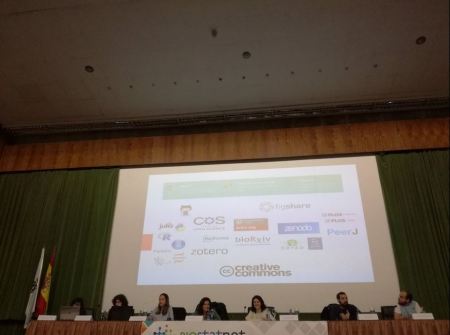
Participants in the roundtable from right to left: Danilo Alvares (with contributions from Elena Lázaro), Miguel Branco, Marta Bofill, Irantzu Barrio and María José López.
BIO Scientific Associations Roundtable
Secondly, a very exciting and lively session gathering researchers with different backgrounds, all members of a variety of BIO associations and networks, gave us their impressions about what it means to work within a multidisciplinary team. In a very constructive and lively atmosphere, promoted by the moderator Erik Cobo (UPC), Juan de Dios Luna (Biostatnet), Vitor Rodrigues (CIMAGO), Mabel Loza (REDEFAR) and Marta Pavía (SCReN) discussed the pitfalls in communication between statisticians and researchers. We all really enjoyed this session, and took home some valuable messages to improve the interactions between (bio)statisticians, clinicians and applied researchers.
Workshops
In addition to a satellite course on “CGAMLSS using R” (post to come on this topic!), we had the opportunity to attend two workshops on the last morning of the meeting.
Juan Manuel Rodriguez and Licesio Rodríguez delivered the Experimental Designs workshop. In a very funny and lively way (and using paper helicopters!!!!), they reviewed key concepts of Experimental Designs. This helpful workshop gave us a great opportunity to dust off our design toolkit.
In the software workshop moderated by Klaus Langohr, Inmaculada Arostegui and Guillermo Sánchez introduced two interactive web tools for predicting adverse events in bronchitis patients (PrEveCOPD) and biokinetic modelling (BiokmodWeb). Esteban Vegas showed a Shiny implementation of kernel PCA, and David Morina and Monica Lopez presented their packages radir and GsymPoint.
Oral communications
Although there were also presentations from less young researchers, there were plenty of sessions for younger members who have been getting a great support from the network (thank you, Biostatnet!). The jury decided that the best talks were “Beta-binomial mixed model for analyzing HRQoL data over time” by Josu Najera-Zuloaga. In his talk, he introduced an R-package, HRQoL, including the methodology to perform health-related quality of life scores in a longitudinal framework based on beta-binomial mixed models, as well as an application in patients with chronic obstructive pulmonary disease. The second awarded talk was “Modelling latent trends from spatio-temporally aggregated data using smooth composite link models. ” by Diego Ayma on the use of penalised composite link models with mixed model representation to estimate trends behind aggregations of data in order to improve spatio-temporal resolutions. He illustrated his work with the analysis of spatio-temporal data obtained in the Netherlands. Our own Natalia presented joint work with researchers from the Basque country node on the application of Multiple Correspondence Analysis for the development of a new Attention-Deficit/Hyperactivity Disorder (ADHD) score and its application in the Imaging Genetics field. This work was possible thanks to one of Biostatnet grants for research visits.
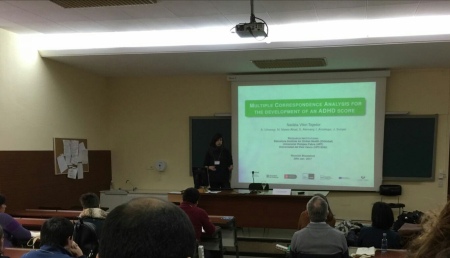
Natalia’s presentation
Posters sessions
Three poster sessions were included in the meeting. As a novelty, these sessions were preceded by a brief presentation in which all participants introduced their posters in 1-2 minutes. Although imposing at first, we thought this was a good opportunity for everyone to at least hear about the work displayed, in case they missed the chance to either see the poster or talk to the author later on. The poster “An application of Bayesian Cormack-Jolly-Seber models for survival analysis in seabirds” by Blanca Sarzo showed her exciting work in a very instructive and visually effective way and won her a well-deserved award too.
Biostatnet sessions
Particularly relevant to Biostatnet members were also the talks by by three of the IPs, Carmen Cadarso, and Guadalupe Gómez and Maria Durbán (pictured below) highlighting achievements and future plans for the network. Exciting times ahead!
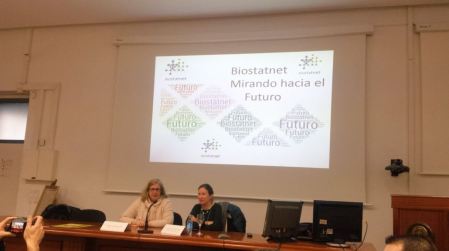
Last but not least, the meeting was a great opportunity for networking while surrounded by lovely Galician food and licor cafe ;p
We look forward to the 4th meeting!

Galician delicacies!
You can check the hashtag #biostatnet2017, tell us your highlights of the meeting here or send us your questions if you missed it…
(Acknowledgements: sessions pics by Moisés Gómez Mateu and Marta Bofill Roig)
